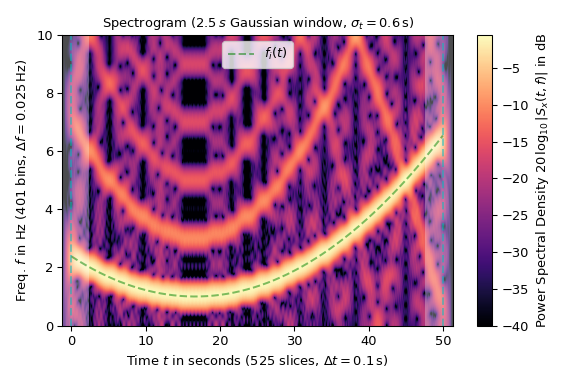scipy.signal.ShortTimeFFT.
频谱图#
- ShortTimeFFT.spectrogram(x, y=None, detr=None, *, p0=None, p1=None, k_offset=0, padding='zeros', axis=-1)[源代码][源代码]#
计算频谱图或交叉频谱图。
频谱图是STFT的绝对平方,即对于给定的
S[q,p],它是abs(S[q,p])**2,因此总是非负的。对于两个STFTSx[q,p], Sy[q,p],交叉频谱图定义为Sx[q,p] * np.conj(Sx[q,p]),并且是复数值的。这是一个方便的函数,用于调用stft/ stft_detrend ,因此所有参数都在那里讨论。如果 y 不是None,它需要与 x 具有相同的形状。参见
stft执行短时傅里叶变换。
stft_detrend从每个片段中减去趋势后的短时傅里叶变换。
scipy.signal.ShortTimeFFT此方法所属的类。
示例
以下示例展示了频率随时间变化的方波 \(f_i(t)\) (在图中以绿色虚线标记)以20 Hz采样的频谱图:
>>> import matplotlib.pyplot as plt >>> import numpy as np >>> from scipy.signal import square, ShortTimeFFT >>> from scipy.signal.windows import gaussian ... >>> T_x, N = 1 / 20, 1000 # 20 Hz sampling rate for 50 s signal >>> t_x = np.arange(N) * T_x # time indexes for signal >>> f_i = 5e-3*(t_x - t_x[N // 3])**2 + 1 # varying frequency >>> x = square(2*np.pi*np.cumsum(f_i)*T_x) # the signal
所使用的高斯窗口长度为50个样本或2.5秒。参数 ``mfft=800``(过采样因子16)和
ShortTimeFFT中的 hop 间隔2被选择以产生足够数量的点:>>> g_std = 12 # standard deviation for Gaussian window in samples >>> win = gaussian(50, std=g_std, sym=True) # symmetric Gaussian wind. >>> SFT = ShortTimeFFT(win, hop=2, fs=1/T_x, mfft=800, scale_to='psd') >>> Sx2 = SFT.spectrogram(x) # calculate absolute square of STFT
图的色图是按对数比例缩放的,因为功率谱密度是以dB为单位的。信号 x 的时间范围由垂直虚线标记,阴影区域标记了边界效应的存在:
>>> fig1, ax1 = plt.subplots(figsize=(6., 4.)) # enlarge plot a bit >>> t_lo, t_hi = SFT.extent(N)[:2] # time range of plot >>> ax1.set_title(rf"Spectrogram ({SFT.m_num*SFT.T:g}$\,s$ Gaussian " + ... rf"window, $\sigma_t={g_std*SFT.T:g}\,$s)") >>> ax1.set(xlabel=f"Time $t$ in seconds ({SFT.p_num(N)} slices, " + ... rf"$\Delta t = {SFT.delta_t:g}\,$s)", ... ylabel=f"Freq. $f$ in Hz ({SFT.f_pts} bins, " + ... rf"$\Delta f = {SFT.delta_f:g}\,$Hz)", ... xlim=(t_lo, t_hi)) >>> Sx_dB = 10 * np.log10(np.fmax(Sx2, 1e-4)) # limit range to -40 dB >>> im1 = ax1.imshow(Sx_dB, origin='lower', aspect='auto', ... extent=SFT.extent(N), cmap='magma') >>> ax1.plot(t_x, f_i, 'g--', alpha=.5, label='$f_i(t)$') >>> fig1.colorbar(im1, label='Power Spectral Density ' + ... r"$20\,\log_{10}|S_x(t, f)|$ in dB") ... >>> # Shade areas where window slices stick out to the side: >>> for t0_, t1_ in [(t_lo, SFT.lower_border_end[0] * SFT.T), ... (SFT.upper_border_begin(N)[0] * SFT.T, t_hi)]: ... ax1.axvspan(t0_, t1_, color='w', linewidth=0, alpha=.3) >>> for t_ in [0, N * SFT.T]: # mark signal borders with vertical line ... ax1.axvline(t_, color='c', linestyle='--', alpha=0.5) >>> ax1.legend() >>> fig1.tight_layout() >>> plt.show()

对数缩放揭示了方波的奇次谐波,这些谐波在10 Hz的奈奎斯特频率处被反射。这种混叠也是图中噪声伪影的主要来源。